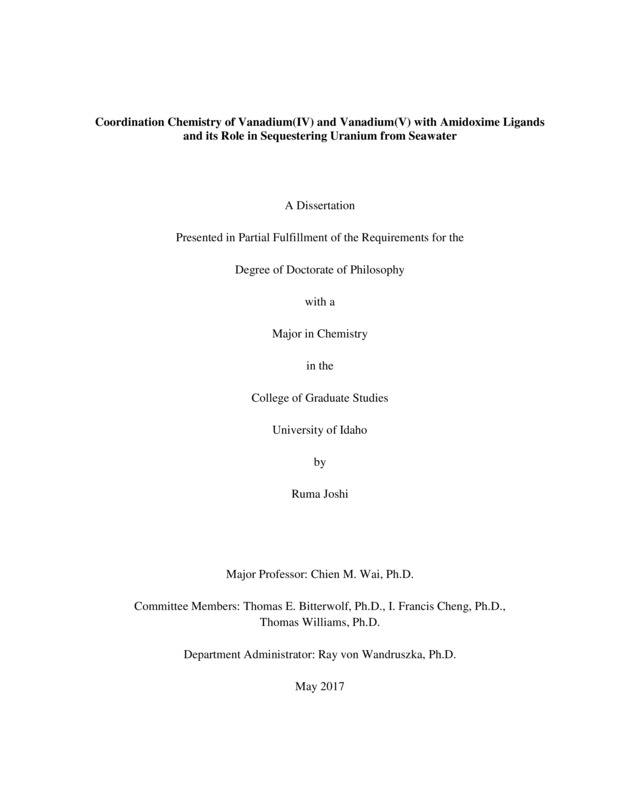Coordination Chemistry of Vanadium(IV) and Vanadium(V) with Amidoxime Ligands and its Role in Sequestering Uranium from Seawater
Joshi, Ruma. (2017). Coordination Chemistry of Vanadium(IV) and Vanadium(V) with Amidoxime Ligands and its Role in Sequestering Uranium from Seawater. Theses and Dissertations Collection, University of Idaho Library Digital Collections. https://www.lib.uidaho.edu/digital/etd/items/joshi_idaho_0089e_11076.html
- Title:
- Coordination Chemistry of Vanadium(IV) and Vanadium(V) with Amidoxime Ligands and its Role in Sequestering Uranium from Seawater
- Author:
- Joshi, Ruma
- Date:
- 2017
- Embargo Remove Date:
- 2018-06-12
- Keywords:
- Amidoxime ligands Uranium for Nuclear Energy Uranium from ocean
- Program:
- Chemistry
- Subject Category:
- Chemistry
- Abstract:
-
Nuclear power is a significant alternative energy resource because it is free of carbon emissions and hence prevents global warming and climate change. Uranium is an essential fuel used for the generation of nuclear power. Since the current uranium deposits of about 63 million metric tons present in terrestrial sources might be exhausted by the end of this century, active research has been done in the past and is still under development for the establishment of a cost-effective technique for the extraction of uranium from seawater.
Chapter one provides an outlook on different energy resources and the importance of nuclear energy. Chapter two highlights the novel approaches explored by various research groups for the extraction of uranium from seawater using amidoxime-based polymer adsorbents. Competition of vanadium with uranium in seawater for adsorption to the amidoxime-based adsorbent is discussed. Chapter three examines the solution phase complexation of glutarimidedioxime and glutardiamidoxime with UO2+2, VO2+, and VO+2 because the knowledge gained will aid in understanding the adsorption of uranium and vanadium using amidoxime-based adsorbents for the extraction of uranium from seawater.
Chapter four uses 13C CP/MAS solid state NMR (SSNMR) spectroscopy for the characterization of a newly synthesized LCW polymer adsorbent derived from acrylic fiber and the Oak Ridge National Lab adsorbent (ORNL-AF1). According to the SSNMR results, the former contains primarily the open-chain glutardiamidoxime groups, whereas the latter contains mainly the cyclic glutarimidedioxime groups. The vanadium uptake by the adsorbents was examined in simulated seawater conditions using the ICP-MS technique. The ORNL-AF1 adsorbent has a higher vanadium adsorption capacity relative to the LCW adsorbent. The result is consistent with the observation made in the solution phase complexation study, which shows that vanadium has a much higher affinity for cyclic glutarimidedioxime than the open-chain glutardiamidoxime.
It should be cautioned that the coordination behavior of metal ions with free ligand molecules may not be the same as the ligand attached to a polymer adsorbent. Nevertheless, the information obtained from the solution phase chemistry of the metal/ligand complexes presented in Chapter three of the dissertation is still valuable for designing new amidoxime-based adsorbents with higher uranium adsorption capacity.
- Description:
- doctoral, Ph.D., Chemistry -- University of Idaho - College of Graduate Studies, 2017
- Major Professor:
- Wai, Chien M
- Committee:
- Bitterwolf, Thomas E; Cheng, I.Francis; Williams, Thomas
- Defense Date:
- 2017
- Identifier:
- Joshi_idaho_0089E_11076
- Type:
- Text
- Format Original:
- Format:
- application/pdf
- Rights:
- In Copyright - Educational Use Permitted. For more information, please contact University of Idaho Library Special Collections and Archives Department at libspec@uidaho.edu.
- Standardized Rights:
- http://rightsstatements.org/vocab/InC-EDU/1.0/

